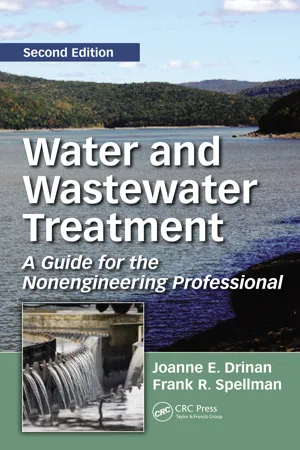
eBook - ePub
Water and Wastewater Treatment
A Guide for the Nonengineering Professional, Second Edition
This is a test
- 300 pages
- English
- ePUB (mobile friendly)
- Available on iOS & Android
eBook - ePub
Water and Wastewater Treatment
A Guide for the Nonengineering Professional, Second Edition
Book details
Book preview
Table of contents
Citations
About This Book
Lauded for its engaging, highly readable style, the best-selling first edition became the premier guide for nonengineers involved in water and wastewater treatment operations. Water and Wastewater Treatment: A Guide for the Nonengineering Professional, Second Edition continues to provide a simple, nonmathematical account of the unit processes used
Frequently asked questions
At the moment all of our mobile-responsive ePub books are available to download via the app. Most of our PDFs are also available to download and we're working on making the final remaining ones downloadable now. Learn more here.
Both plans give you full access to the library and all of Perlego’s features. The only differences are the price and subscription period: With the annual plan you’ll save around 30% compared to 12 months on the monthly plan.
We are an online textbook subscription service, where you can get access to an entire online library for less than the price of a single book per month. With over 1 million books across 1000+ topics, we’ve got you covered! Learn more here.
Look out for the read-aloud symbol on your next book to see if you can listen to it. The read-aloud tool reads text aloud for you, highlighting the text as it is being read. You can pause it, speed it up and slow it down. Learn more here.
Yes, you can access Water and Wastewater Treatment by Joanne E. Drinan,Frank Spellman in PDF and/or ePUB format, as well as other popular books in Technology & Engineering & Environmental Management. We have over one million books available in our catalogue for you to explore.
Information
section two
Basics of water treatment
Chapter Two
Water regulations, parameters, and characteristics
Purpose: Quality parameters for water
The unit processes used to prepare raw or untreated water for public use and consumption are controlled and determined by water quality parameters. These parameters are set by federal regulations and are supported and strengthened by state law. Individual facilities must prove they meet regulatory standards through regulated programs of testing and reporting (see Figure 1.1).
Purpose: Water treatment
Treatment for drinking water removes from raw water those contaminants (Table 2.1) harmful or unpleasant to humans by a confirmed series of treatment steps or unit processes that produce safe potable water. In raw water treatment, the goals are to remove pollutants that affect water quality and to ensure that water safe for consumption is delivered to the consumer.
Table 2.1
Common Chemical Pollutants
Source | Common associated chemical pollutants |
|---|---|
Cropland | Turbidity, phosphorus, nitrates, temperature, total solids |
Forestry harvest | Turbidity, temperature, total solids |
Grazing land | Fecal bacteria, turbidity, phosphorus |
Industrial discharge | Temperature, conductivity, total solids, toxics, pH |
Mining | pH, alkalinity, total dissolved solids |
Septic systems | Fecal bacteria, (i.e., Escherichia coli, Enterococcus), nitrates, phosphorus, dissolved oxygen/BOD, conductivity, temperature |
Sewage treatment plants | Dissolved oxygen and BOD, turbidity, conductivity, phosphorus, nitrates, fecal bacteria, temperature, total solids, pH |
Construction | Turbidity, temperature, dissolved oxygen and BOD, total solids, and toxics |
Urban runoff | Turbidity, phosphorus, nitrates, temperature, conductivity, dissolved oxygen, and BOD |
Water quality: Federal regulations
Water quality standards are controlled by federal regulation, applied on all levels. After water quality standards came into law in the 1970s, the condition of our drinking water supplies improved drastically. These improvements were the result of two critically important regulations: the Safe Drinking Water Act (SDWA), passed by Congress in 1974, and the Water Pollution Control Act Amendments of 1972 (...
Table of contents
- Preliminaries
- Preface
- Acknowledgments
- About the authors
- On the cover: Pepacton Reservoir
- Section One: Introduction
- Section Two: Basics of water treatment
- Section Three: Basics of wastewater treatment
- Section Four: Basics of water and wastewater solids treatment and management
- Glossary